|
The major renewal of the Westinghouse Memorial started in 2011 in Schenley Park is now complete! The Pittsburgh Parks Conservancy partnered with the City of Pittsburgh in 2009 to renew this remarkable space with the financial help and support from members of the Pittsburgh Vintage Grand Prix's Cortile Italian Car Show participants. The fully restored Westinghouse Memorial includes a reestablished lily pond; renewed memorial sculpture; native plant landscape; new nighttime lighting; and stormwater management and we will be celebrating on the newly completed restoration this July 15- 16! About the Westinghouse MemorialLocated near the entrance to the Steve Faloon Trail, this memorial to George Westinghouse has been a distinctive feature of Schenley Park since its dedication in 1930. Originally financed by small donations from over 55,000 Westinghouse employees, it encompasses history, art, and natural beauty. Architects Henry Hornbostel and Eric Fisher Wood designed the monument and the surrounding landscape, including the pond, trees, and location of black granite benches. They chose sculptor Daniel Chester French to design the sculptures, including the bronze “The Spirit of American Youth,” the figure of a young man taking inspiration from the life of Westinghouse, which was described by art critics as “the finest portrayal of American boyhood.” The center portion of the monument depicts Westinghouse between a mechanic and an engineer. The surrounding panels were created by French’s collaborator, sculptor Paul Fjelde, to illustrate Westinghouse’s achievements. The boy stands facing the wall dedicated to George Westinghouse, and is supposed to take inspiration from the other man's life. The boys carries books in one arm and a hat in the other. The memorial was originally financed from $200,000 in donations made by approximately 55,000 workers of Westinghouse companies in electricity. It was dedicated on 6 October 1930. There opening ceremony was attended by over 10,000 people, including U.S. Representative James F. Burke and Pittsburgh mayor Charles H. Kline, and a celebratory dinner was held the night before at the William Penn Hotel. The memorial was on the original site of the Pittsburgh Zoo. The Westinghouse Foundation paid for the memorial's restoration in 1986 in honor of the centennial of Westinghouse Electric. About Schenley ParkSchenley Park began as "Mt. Airy Tract," which was property willed to Mary Elizabeth Croghan by her maternal grandfather, General James O'Hara. In 1842, 15-year-old Mary created an international scandal by leaving her Staten Island boarding school and eloping to England with the 43-year-old Captain Edward Schenley (Pronounced "Sheen lee"). Distraught by the news, Mary's father initiated a lengthy legal battle over her inheritance, successfully winning the title to all her property. Mary and her father eventually reconciled, and she received her inheritance upon his death in 1850. Edward Bigelow, Pittsburgh’s Director of Public Works, envisioned a grand park system for Pittsburgh, and no piece of land was more desirable than Mt. Airy Tract. When Bigelow learned in 1889 that a real estate developer's agent planned to travel to London to convince Mary Schenley to sell them her land, he sent an East Liberty lawyer who hopped a train for New York and then boarded a steamer for England - beating the real estate agent by two days. The appeal to Mary paid off, and in 1889 she gave the city 300 acres of Mt. Airy Tract with an option to purchase 120 more, provided the park be named after her and never sold. The city bought the extra acres in 1891, and later purchased some adjoining land to complete the park. Bigelow's plans for the park system included a system of boulevards that would link them together, and he began constructing bridges in Schenley Park to make it easier for travelers to reach the park. The first, constructed in 1897, was the Bellefield Bridge, which spanned St. Pierre's Ravine and linked Bigelow Boulevard to the Carnegie Institute of Technology (now Carnegie Mellon University). When St. Pierre's Ravine was filled in around 1911 (providing a solid foundation for what is now Schenley Plaza), the Bellefield Bridge was buried along with it and is today the foundation for the Mary Schenley Memorial Fountain. The Panther Hollow Bridge opened in 1897, followed by the Junction Hollow Bridge in 1898. While two of the three bridges remain, many of the attractions to which they provided access in the 1890s have disappeared. Among them: a 120-foot circular electric fountain on Flagstaff Hill that offered nighttime light shows; the marvelous Schenley Casino (on the site of the present-day Frick Fine Arts Building), which featured Pittsburgh's premier indoor ice skating rink but was destroyed by fire after only a year; and a band shell designed by architects Rutan and Russell on the site of the present-day Anderson Playground. 1907-1909 saw the development of park features that are still present today: the Schenley Oval and racetrack, the tufa bridges in Panther Hollow, and Panther Hollow Lake, which was created from an existing small body of water. The park also underwent large-scale planting in its early years. Bigelow's reports indicate that the land was mostly barren when the City acquired it, and he pursued the highest standards of horticulture in hiring William Falconer, who was trained at London's Kew Gardens, to take charge of Phipps Conservatory and of the park's landscape. Falconer's tenure lasted from 1896 to 1903. Schenley Park underwent a second period of growth in the 1930s and 1940s during Ralph Griswold's tenure as the Director of Public Works. Griswold designed several gardens around Phipps Conservatory, but the park's biggest change was the construction of the Anderson Bridge, which brought the Boulevard of the Allies through the park and linked Squirrel Hill to Downtown. Since then, there have been few major changes to the park as a whole, as certain amenities (like the Panther Hollow Boathouse) have disappeared while others (the ice skating rink) were introduced. Click here to read an article by Parks Curator Susan Rademacher about the fascinating life and legacy of Mary Schenley.
0 Comments
The 2015 Amelia Island Concours d'Elegance held March 13-15 featured a unique gathering of 26 cars that where all raced by Sir Stirling Moss. The Italian contingent included the a select group of Moss's racing cars including Ferrari's, a 250 GTO, a 250 GT Speciale ‘Sperimantale’, a 250 TRi/61 and 290 MM and the trident badged Maserati's including a 250F, a 300S, a 450S and a Tipo 61 Birdcage. 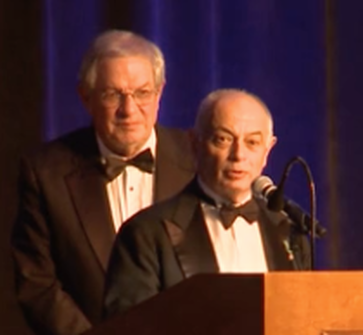 Amongst the many cars on display where portions of the Auriana Collection that was featured both as part of the Alfa Romeo corporate display as well as rolling around the showfield turning heads and eliciting admiring whistles. Lawrence Auriana, is a successful businessman and very well-regarded in the historic racing community. Professionally, Auriana is a Senior Portfolio Manager and founder of the Federated Kaufmann Fund, part of Federated Investors based in Pittsburgh. Auriana has also been President, Chairman of the Board and Treasurer of the Columbus Citizens Foundation which celebrates Italian-American Heritage. The organization produces New York’s annual Columbus Day Parade as part of the Columbus Week Celebration which is the world’s largest series of events that pays homage to Italian-American friendship, cooperation and culture. "My collection is a tribute to the contribution of Italy to the automotive industry. It's much more than the red cars from Marenello. It's the red cars from Modena, the red cars from Milano, Torino. It's Abarth, Moretti, Stanguillini... My cars are a tribute to a group of Italians that made an important contribution to the automotive industry in the 20th century. The Great designers, engineers, and sportsmen who raced these cars and we hope to share those cars with all of you" Needless to say, Larry Auriana's words capture the essence of the upcoming Marques of Italy celebration at the 2015 Pittsburgh Vintage Grand Prix and the very essence of the spirit in which was the Cortile Italian Car show's inception. Drool with us now as you read some of the unique bio's of a small part of the Aurianna Collection below that was on display at Amelia Island. Auriana is a well-known and respected collector of classic cars and motorcycles and the owner of a successful historic racing team, Fratelli Auriana Racing. His collection celebrates the superior design of the Italian Automotive Industry. His cars have won a list awards around the world that is so prestigious and long that listing them could take up this entire article. Perhaps one of the most recent and important awards is the Lee Iacocca Award he won at 2014 Amelia Concours d'Elegance. The Lee Iacocca Award was established to recognize outstanding classic car enthusiasts and is given for "Dedication To Excellence In Perpetuating An American Automotive Tradition". The award celebrates auto enthusiasts on multiple levels, including character, community involvement, integrity and a level of excellent presentation of their vehicle. Larry Auriana certainly embodies all of that. According to Auriana, 1933 Alfa Romeo 8C 2300 Monza Spider CorsaThe Alfa Monza, owned by Auriana , is believed to be the model raced by Tazio Nuvolari in his winning bid in the 1932 Monaco Grand Prix. It later was entered in the 1933 Monaco Grand Prix and French Grand Prix and, in 1934, placed second in the British Empire Trophy Race, when it was driven by Charles Brackenbury. Chassis 2211125, 2,556cc inline 8-cylinder, 178hp, supercharged DOHC, 4-speed manual transmission, 4-wheel drum brakes. This 8C 2300 2.6-liter Monza Corsa Spider was delivered to Tim Birkin on April 19, 1933, just days before the 1933 Monaco GP. It is known that Tazio Nuvolari drove an undocumented new Monza to a spectacular victory in Monaco that year, many believe this is the car he drove, but no direct connection with 2211125 has ever been proven or disproven. It did race in June 1933 at the GP de Frontieres at Chimay, driven by Clifton Penn Hughes where it finished second, then a week later driven by Captain George Eyston in the French GP at Montlhéry with a respectable third place. It was sold and shipped to England and continued racing throughout the mid 30’s. In 1937 it was sold to American Sam Bird, who kept the car in England until the end WWII. After arriving in the U.S., Bird ‘s nephew George Huntoon returned the Monza to competition, entering and winning the inaugural 1949 road race at Bridgehampton, Long Island. It also ran in the 1949 race at Watkins Glen, leading from the start but eventually suffering damage and retiring. Huntoon sold the car in 1953 to Art Roberts who in turn sold it in June 1955 to Norman Andrews, a Sunman, Indiana egg farmer, for $2,100 complete with 13 wheels and tires, the original distributor, a magneto, Monza exhaust header. 2211125 lay unused until 1968 when Andrews sold it to Arthur Jacobs in Mineola, Long Island. A decade later in 1978, it was acquired by Paul Grist, who began a comprehensive restoration that emerged mechanically fresh, but with a gently aged patina. It was sold in 1991 to the late Terry Cohn, a consistent competitor and participant in historic events around the world. Auriana bought the car in 2002 and it participated in the 2007 Mille Miglia with co-drivers Italian Navy Admiral Giovanni Vitaloni and Joseph Colasacco. From 1931 through 1937, Alfa Romeo Monza sports cars dominated road racing. The 8c 2300 featured a 2300 cc in-line eight-cylinder engine and was designed by Vittorio Jano and was crowned a supreme feat of engineering by the foremost drivers of the day — Nuvolari, Borzacchini, Varzi, Campari, Brivio and Trossi — all of whom raced the Monza. The Alfa Romeo 8c 2300 acquired the "Monza" designation after Nuvolari drove the car to his 1932 Italian Grand Prix win in a race in Monza, Italy. Only a handful of the Alfa Romeo 8C 2300 sports cars are known to have survived the gruelling demands of road racing in the mid-20th century. They are among the most highly sought after cars in the world. 1953 Alfa Romeo 6C 3000 CM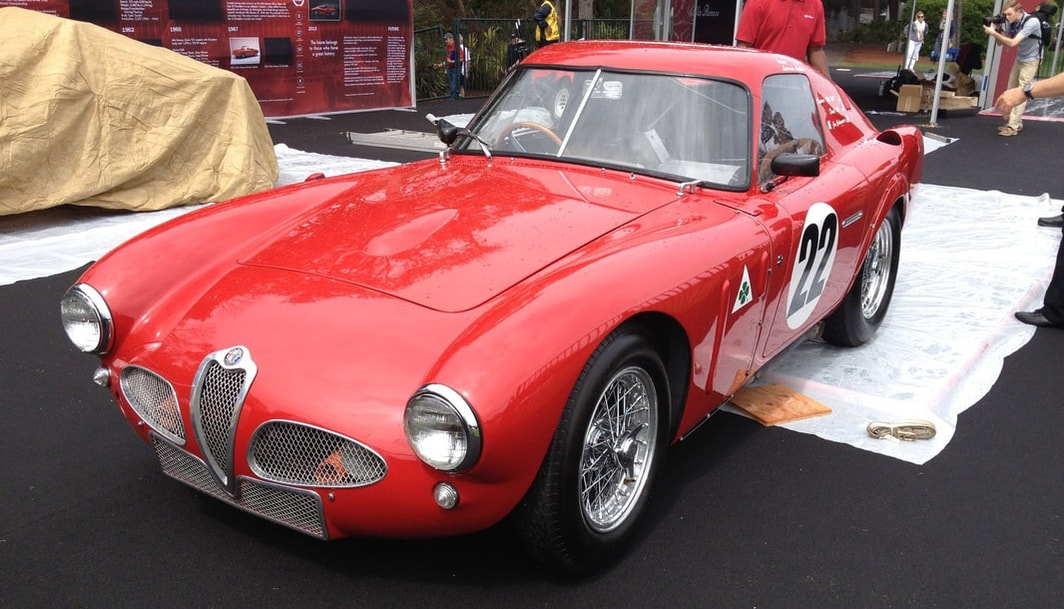 1953 ALFA ROMEO 6C 3000 CM. Chassis 00126, 3495cc inline six-cylinder, 275hp @ 6500 rpm, aluminum body over steel tubular frame chassis. First raced by Juan Manuel Fangio at the 24 Hours of Le Mans in 1953, this Alfa Romeo 3000 CM has had a very thrilling life. Designed for road and track racing, this rare Alfa Romeo was engineered for the 1953 Sport Cars World Championship and namely to take part to the Mille Miglia and 24 Hours of Le Mans races. It is one in a series of six cars first built by Alfa Romeo that year. Four were berlinettas (coupes) and two spiders, all originally made by Carrozzeria Colli. In the spring of 1955 the Alfa Romeo factory received a somewhat special order. It came from the Argentine presidential palace, the President would like to have a special version of Alfa’s 6C 3000. Well, a stock of 6C cars at the factory wasn’t exactly available, so you had to find a donor car. One of the factory’s engineers, Giuseppe Busso, got the job. From Alfa’s stock he found a donor car with chassis no. AR * 1361.00126. This was a Berlinetta, with a body of Colli. The car had driven 24 hours of Le Mans in 1953, in fact the last time Alfa Romeo officially participated in the race. The driver at the time was none other than Juan Manuel Fangio, another Argentine connection to the car. Allegedly, Fangio had later damaged the car violently. Busso had to remove the body and begin a major restoration work on the chassis. Then it was transferred to Mario Boano, whom would create a new body on his carozzaria Boano. At least four of those racecars were subsequently re-bodied by famous coachbuilders. Boano re-bodied this car in 1954 and one year later, in 1955, Alfa Romeo presented the new sport car to General Juan Peron, president of Argentina. In August 1970, noted Alfa Romeo collector H.W. Wessells brought the 6C 3000 CM back to life was when he bought it from Ed Bond of the Vintage Car Store in Nyack, NY. The second revival started after Wessells totaled the Boano Berlinetta racing it in the 1984 Pittsburgh Vintage Grand Prix. He decided to restore the CM in Italy with Salvatore Diomante of Autocostruzioni S.D. at Nichelino who returned to its original Colli Coupe body design. This car was called “Tipo 6C 3000 CM” where CM does not stand for Campionato del Mondo, nor for Competizione Maggiorata, nor Corte Maggiore but stands for “Cilindrata Maggiorata” because of its increased (maggiorata) displacement (cilindrata). Mr. Wessells sold this car to current owner, an Italian car collector for whom both the late Phil Hill, son Derek Hill and Joe Colasacco have driven at Monaco, Le Mans, Goodwood and Monterey. 1968 Alfa Romeo Tipo 33/2 Stradale The Alfa Romeo Tipo 33 Stradale is arguably one of the most beautiful cars ever made and one of the rarest too, since the Italian carmaker only built 18 road-going versions of the Tipo 33 racer. Of these, fewer than 10 are known to exist today. The car takes 5.5 seconds to reach 60 mph (96.6 km/h) from a standing start and has a top speed of 260 km/h (160 mph). In 1968 it was the fastest commercially available car in the standing kilometer with time of 24.0 seconds measured by German Auto, Motor und Sport magazine. Similar performance cars on that time were all using twice the Stradale`s cylinder capacity, the Lamborghini Miura, Ferrari Daytona and Maserati Ghibli. 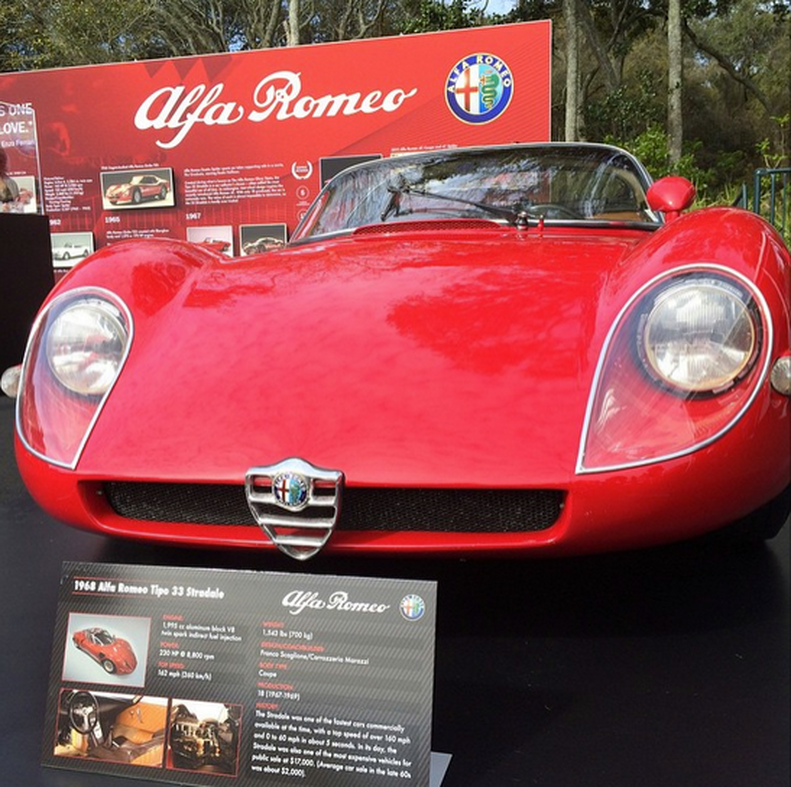 Hidden in the trailer is one of the sexiest front profiles ever. Elegantly formed wings are filled with teardrop headlight cowls, the chrome applied like a Vogue cover girl’s eyeliner. The delicate Alfa shield sits proudly on an aggressive, narrow grille. Rarely are power and beauty melded so masterfully.” Mick Walsh, Classic & Sportscar magazine, January 1999 Chassis 75033.133, 1995cc V8, 230bhp @ 8800rpm Designed by Franco Scaglione and built by Carrozeria Marazzi this spectacular car was based on the Autodelta T33 racecar at the request of the director of Autodelta, Carlo Chiti. Dubbed the Alfa Romeo 33 “Stradale” (road-going), it was first shown at the Sports Car Show in Monza in September of 1967. Built in an attempt by Alfa to make some of its racing technology available to the public, it was the most expensive automobile for sale to the public in 1968 at US$17,000. The 33 Stradale is the first production vehicle to feature dihedral doors, also known as butterfly doors. The 33 Stradale also features windows, which seamlessly curve upward into the 'roof' of the vehicle. The car has aluminum body on aluminum tubular chassis. As a result of being built by hand, each model differs from the others for some details. For example, early models had twin headlights, replaced in the last ones by single lights. The position of the windscreen wiper, and even the number of them, is another thing that differentiates each example from the others. Also the late models have vents added behind both the front and rear wheels to allow hot air from the brakes to escape. “In those days there was no speed limit in Italy and the police only stopped you out of curiosity. More often they would gesture you on: “Avanti, Avanti.” Once, on the autostrada to Venice, I ran it for 4km at its 10,000rpm rev limit in sixth. I clocked it at 180mph. Amazingly, below 150mph there was little engine noise, but past 160 it became really intense inside. The car was fantastically stable- even in crosswinds it still ran brilliantly straight.” Henry Wessells II, American motoring connoisseur and first private owner of a Stradale. The race-bred engine bore no relation to the mass-produced units in Alfa's more mainstream vehicles. The engine is closely related to the V8 of the Alfa Montreal, albeit with smaller capacity and in a much higher state of tune. Both engines were derived from the 33 racers‘ but differed in many details. Both engines had chain driven camshafts as opposed to the racers‘ gear driven ones, but the Stradale kept the racing engine’s flat plane crankshaft, whereas the Montreal engine had a cross plane crank. Race engineer Carlo Chiti designed an oversquare (78 mm (3.1 in) bore x 52.2 mm (2.1 in) stroke) dry-sump lubricated all aluminum 1,995 cc (121.7 cu in) V8 that featured SPICA fuel injection, four ignition coils and 16 spark plugs. The engine used four chain-driven camshafts to operate the valve train and had a rev-limit of 10,000 rpm. The engine produced 230 hp (172 kW) at 8,800 rpm in road trim and 270 bhp (201 kW) in race trim. The engine valves are operated via chain-driven double-overhead cams and has a 10.5:1 compression ratio. Because every Stradale is hand built and unique the power levels can vary by car, used rpms etc., for example the first production Stradale (No. 750.33.101) has factory datasheet that claims 243 hp (181 kW) at 9,400 rpm with a "street" exhaust and 254 hp (189 kW) with open exhaust In another break from convention Alfa used, for the first time on a production car, a six-speed transaxle gearbox by Valerio Colotti. The car has 13-inch Campagnolo-made magnesium wheels and Girling disc brakes on all four corners, the rear ones are inboard type. Despite the wheel diameter being just 13 inches the wheels are eight and nine inches wide, front and rear. Suspension is like in mid-1960s race car with upper and lower control arms in front and double trailing arms in the rear, along with substantial antiroll bars. Mr Auriana drove a 1972 Tipo 33/TT/3 In the 1972 Daytona Race Maserati 250FFangio had demonstrated that the Lancia-Ferrari D50 was the car to beat at the 1956 German Grand Prix, where Stirling Moss had qualified in fourth place behind the Italian cars in a Maserati 250F, going onto finish in second place in the race behind the great Argentinian. For the Italian Grand Prix, in much the same way that modern Formula 1 teams revise and update cars between races, Maserati produced a car that had been revised considerably. Stirling recalled that Maserati “would have to pull something pretty dramatic out of the bag for Monza” and they did. Two new 250F chassis were built, one for Stirling and one for Jean Behra, with off-set prop-shafts, which allowed the driving position, and therefore the centre of gravity, to be considerably lowered, thus improving the handling. Despite a good start by Stirling, the Lancia-Ferraris quickly asserted themselves in the first four places, although, happily for him, this turned out to be short lived. On the fifth lap of the 50 lap race, both Castellotti and Musso paid the price for pushing too hard too soon and their rear tyres started throwing treads. In a scene reminiscent of the current 2011 season both the Lancia-Ferrari drivers pitted for new tyres. This left Stirling in the lead from Schell, Collins and Fangio who had dropped back in his Lancia-Ferrari to this chasing group. “We became locked in quite a battle and with 15 laps gone I was only 0.6 seconds ahead of Harry” Stirling recalls. With 5 laps to go Stirling ran out of fuel. Stirling recalls “I spotted (Luigi) Piotti, the Italian Maserati privateer, coming up behind and gestured frantically for him to use his car to push me to the pits”. Luckily for Stirling he understood and the Maserati’s proceeded to the pits nose to tail, with Stirling’s 250F receiving what would be in modern terms, a splash and dash. Coming out of the pits he went on to record the a fastest lap of the race in a time of 2m 45.4s at a speed of 135.5mph in an effort to catch Musso's Lancia-Ferrari. Stirling's mechanics then had to signal to him to slow down as they could see patches of canvas appearing on his tyres. With 3 laps to go, fate intervened yet again and the Lancia-Ferrari driver suffered a broken steering arm as the car came off the final banking, coming to a stop sideways and out of control by the pits. Stirling was ahead yet again, on tyres that were down to the canvas casings, depsite this, he went onto win the race by six seconds from a fast closing Fangio in a time of 2 hours 23 minutes 41.3 seconds, at an average speed 129.73mph. Fangio’s second place, gave Stirling's former team mate yet another World Drivers’ Championship. For Stirling, winning at Monza in an Italian car made up for loosing the 1954 race in the Mercedes streamliner, it also meant a great deal to the “tifosi”, the passionate Italian fans, who rightly viewed this victory as one of Stirling’s finest to date.
|
AtributionThis is a compilation of articles from a variety of sources and contributors. Attrition and sources are always provided at the top and/or the bottom of the posting. Archives
August 2023
Categories
All
|

The Pittsburgh Vintage Grand Prix Association is a federally registered 501c (3) non-profit organization with a mission to hold a world-class vintage automotive race event for charity.
Since 1983 this volunteer-driven event has raised over $6 million to benefit autistic and developmentally disabled individuals through the Autism Society of Pittsburgh and Allegheny Valley School. The Pittsburgh Vintage Grand Prix remains North America's largest vintage race event, the only one run on city streets, and the 8th largest car show in the World. |

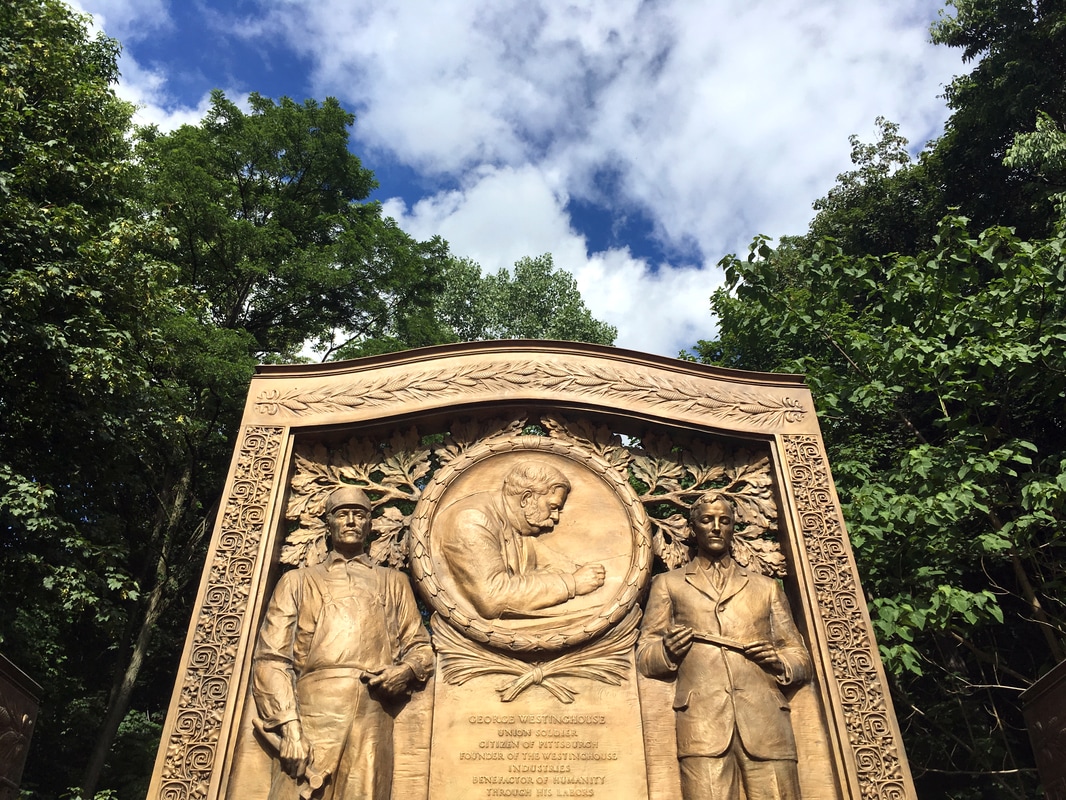
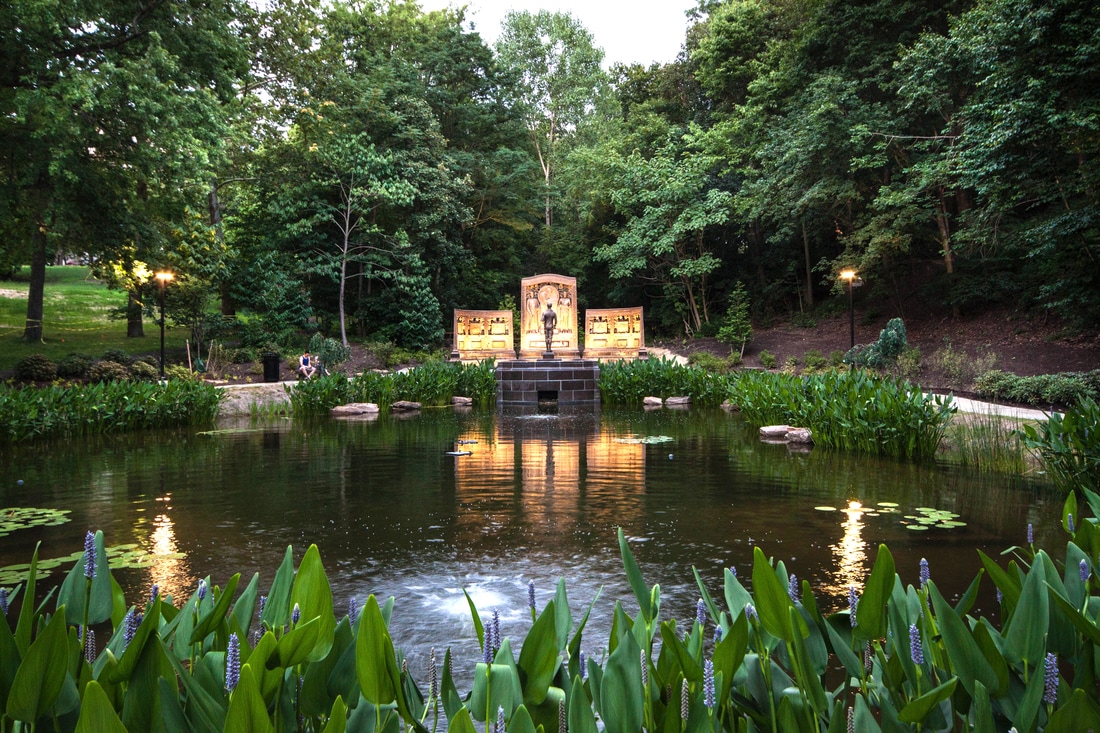
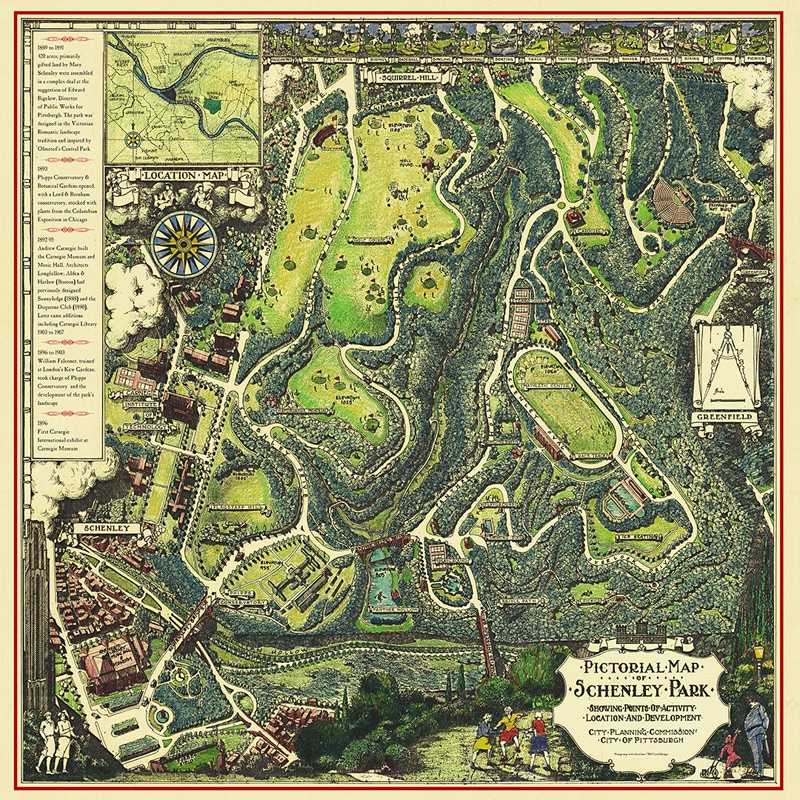

 RSS Feed
RSS Feed